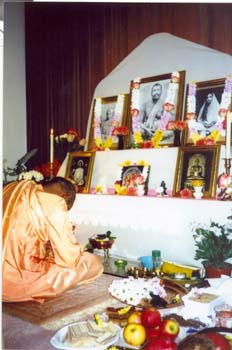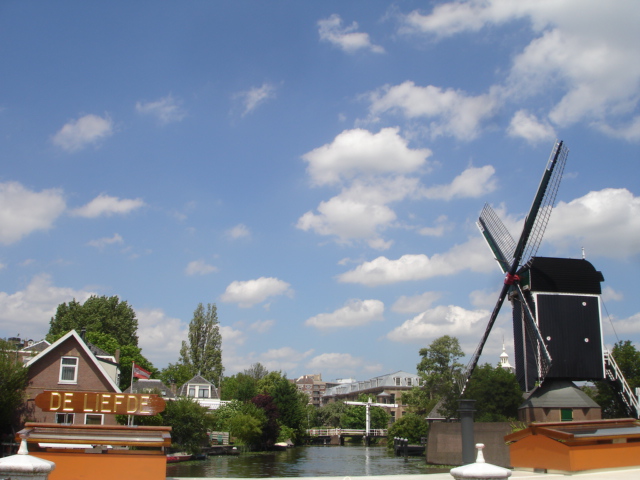by Annapurna
During the early part of July, I had the blessing of attending the Ramakrishna Vedanta Vereniging Nederland in Amstelveen, outside of Amsterdam. Public transportation in Holland was more efficient than I could imagine, thus, travelling from downtown Amsterdam by electric bus, train, and finally bus, I stilI arrived too early and sat in the park nearby until it was 4pm. Swami Sarvatmanandaji graciously welcomed me to their quiet center in a Dutch neighborhood. The Center occupies a corner apartment in an “L” shaped complex of modest townhouses. The lower level houses a large classroom, library, and shrine room.
 After a brief meeting with Swami, members began arriving for a daily, pre-vespers reading from the Gospel of Sri Ramakrishna (in English, thankfully). Afterwards, we entered the small shrine room for arati and meditation. It was so wonderful — and, a relief, actually, to be in the palpable purity of a Ramakrishna Order shrine room. After a week of tourist activities, I was truly ready for the peace and sanctity of Master and Mother’s Dutch residence. After meditation, there was satsang with Swami Sarvatmanandaji and also prasad.
After a brief meeting with Swami, members began arriving for a daily, pre-vespers reading from the Gospel of Sri Ramakrishna (in English, thankfully). Afterwards, we entered the small shrine room for arati and meditation. It was so wonderful — and, a relief, actually, to be in the palpable purity of a Ramakrishna Order shrine room. After a week of tourist activities, I was truly ready for the peace and sanctity of Master and Mother’s Dutch residence. After meditation, there was satsang with Swami Sarvatmanandaji and also prasad.
Among the notes from my time there is a teaching out of the Gospel that I had not picked up on before, and which Swami Sarvatmananda elucidated on. It concerned the teaching of divine love — how bhakti matures into raga bhakti and ultimately into prema. But what do you call love before it is bhakti? Bhakti, the way that Sri Ramakrishna taught it, is a highly pure state of mind/heart. The devotee is seeking or has attained to love of God for the sake of love and nothing else. So what is love before it is bhakti? It is kama. One’s love is full of desires of a material nature until bhakti dawns. Very simple and obvious, but I had been at a loss for what word is to be used for ordinary love.
It was of great interest for me to learn that Swami Sarvatamananda has been in the West for over 15 years and is connected to others important in my life and in SRV’s history. He met Lex Hixon while he was serving Swami Sarvagatananda in Boston. He later served under Swami Swahananda of Hollywood. The swami also met Swami Aseshanandaji and his monastic disciples at their sannyas ceremony. In 2000, he came to the Netherlands’ center to serve as their spiritual leader. It was delightful to learn of his interest in all Ramakrishna centers, in all those who are trying to do Thakur’s work, whether they are managed by the Order or not. As he related it, Thakur can and is continuing to inspire people to do this work. And, enigmatically, he added, paraphrasing something Holy Mother said, “Mother’s children are different.” Swami graciously accepted a couple stacks of Nectars for the devotees there and also a collection of Babaji’s books for the library. Many people in Holland are able to read in English (and also speak it fluently). Swami Sarvatmanandaji was so generous with his time and encouragement as our conversations went deeper. His blessings at the time of my departure are one of the sweetest memories of my time in The Netherlands.
The Netherlands’ center publishes a small journal in Dutch twice a year on Vedantic teachings and articles on the direct disciples. They make past issues available online. There is a much needed and ongoing work of translating important books and materials into Dutch. I met a few of the people involved in this pioneering work.
 Throughout my visit in Holland I noticed many empty or little-used churches and an apparent disinterest in religion, at least traditional religion. My time was too short, and meetings too selective to gather a balanced opinion on this. However, it seemed that among educated people there is the idea that religion is simply superstition. But there is an interest in meditation, though I did not meet anyone who was practicing it. The Vedanta Society there was in its summer, low attendance cycle and everyone I met was well over 50. I asked Swami about this and he replied that the younger generation is too externalized, and added that those who are looking for something have a lot of other choices too — Buddhism, Satya Sai Baba, ISKON, and others. However, he gets invited to a Yoga Vedanta center a few times a year to give a talk. Despite low attendance during summer, special meetings can see a surge of up to 50 people, though, typical of Vedanta Societies in the U.S., many of these are cultural Hindus.
Throughout my visit in Holland I noticed many empty or little-used churches and an apparent disinterest in religion, at least traditional religion. My time was too short, and meetings too selective to gather a balanced opinion on this. However, it seemed that among educated people there is the idea that religion is simply superstition. But there is an interest in meditation, though I did not meet anyone who was practicing it. The Vedanta Society there was in its summer, low attendance cycle and everyone I met was well over 50. I asked Swami about this and he replied that the younger generation is too externalized, and added that those who are looking for something have a lot of other choices too — Buddhism, Satya Sai Baba, ISKON, and others. However, he gets invited to a Yoga Vedanta center a few times a year to give a talk. Despite low attendance during summer, special meetings can see a surge of up to 50 people, though, typical of Vedanta Societies in the U.S., many of these are cultural Hindus.
A little history about the center:
During Swami Vivekananda’s first visit to the West, he spent three days in Amsterdam in 1897. Later, in the 1930’s Swami Yatiswarananda gave a few lectures in Holland while preaching in Germany. The Vedanta work really got started in the Netherlands in 1961 when Swami Ranganathananda (later became 13th President of the Ramakrishna Math and Mission) visited the country and later gave lectures every year between 1971 and 1986 at the invitation of Yoga and Vedanta groups. This center was officially taken over by the Ramakrishna Order in 1990 and Swami Chidbhasananda was the first minister.
Relatedly, and of special note, the West’s first monk of the Ramakrishna Order came from The Netherlands, Swami Atulananda. His story can be found in his book, With the Swamis in America and India.
